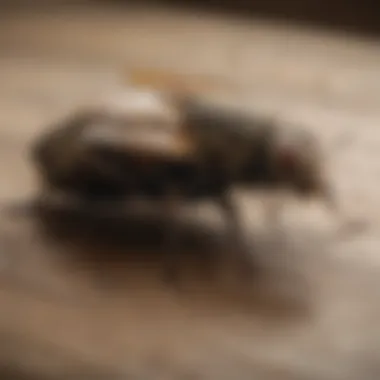Fast and Effective Ways to Eliminate House Flies


Intro
Dealing with flies in your home can be more than just a nuisance. These pests are not only annoying but can also pose health risks due to their ability to contaminate food and surfaces. Understanding how to effectively tackle this issue is vital for maintaining a clean and healthy living environment. This guide aims to provide practical, immediate solutions to eliminate flies from your house quickly.
Understanding Pests
Definition of Pests
Pests are organisms that negatively affect human activities, often by damaging property or causing health risks. Flies are a common type of pest that thrive in warm climates and reproduce quickly. With many species, including house flies and fruit flies, it's crucial to recognize what kind of fly you’re dealing with to apply the most effective control methods.
Importance of Pest Identification
Identifying the specific species of fly is essential. Different species have varying habits and preferences that influence how you should approach eradication. For example, house flies are attracted to decaying matter and waste, while fruit flies prefer ripening or rotting fruits and vegetables. Proper identification leads to a more tailored approach, enhancing the chances of successfully getting rid of them.
Prevention Techniques
Home and Garden Preventative Measures
Preventing flies from entering your house is the first step in pest management. Here are some strategies:
- Seal Entry Points: Check for gaps in windows, doors, and walls. Use screens and weather stripping to prevent flies from finding their way inside.
- Maintain Cleanliness: Regularly clean your kitchen and dining areas, especially spills and crumbs. Flies are attracted to food remnants.
- Remove Waste Promptly: Dispose of garbage and compost regularly. Store trash in sealed containers to cut off food sources.
- Control Outdoor Attractions: Keep your garden tidy and remove any rotting fruit or overripe vegetables. Cover compost bins tightly.
Seasonal Prevention Tips
Flies are more prevalent in warmer months. To deter them during peak seasons, consider these tips:
- Use Fans: Flies are not strong flyers. Placing fans in strategic locations can create airflow that deters them.
- Plant Aromatic Herbs: Certain herbs like basil and mint can repel flies. Incorporate these plants in your garden or window sills.
Eco-Friendly Pest Control Solutions
Overview of Sustainable Practices
Adopting eco-friendly pest control solutions not only respects the environment but can also be effective. Using chemicals can harm beneficial insects and create health risks for humans and pets. Consider these sustainable practices:
- Biological Control: Introduce natural predators, such as certain types of wasps that feed on fly larvae.
- Traps: Set up non-toxic traps that capture flies without the use of harmful chemicals.
Natural Remedies and Their Effectiveness
Several natural remedies can also help in managing fly populations:
- Vinegar and Dish Soap: A mixture of apple cider vinegar and a few drops of dish soap can attract and trap flies.
- Essential Oils: Citronella and eucalyptus oils can act as natural repellents. Mix with water and spritz around your home.
Use these methods consistently to see the best results in managing fly populations.
These comprehensive strategies ensure you keep your home fly-free and maintain a safe environment. By combining prevention techniques with eco-friendly solutions, you can effectively manage flies in your residence.
Preamble
The presence of flies in a home can be a significant nuisance. These insects not only create an unpleasant environment but can also lead to hygiene concerns. Flies are often carriers of disease-causing pathogens. Therefore, understanding how to effectively eliminate them is critical for maintaining a healthy living space.
In this article, we will discuss various approaches to getting rid of flies quickly. We will focus on immediate solutions and long-term preventive measures. There are multiple fly species that may invade your home, each with distinct behaviors and breeding habits. Recognizing these characteristics allows for more effective interventions.
This guide aims to provide housewives and homeowners with actionable methods to address fly infestations swiftly. The convenience of having a fly-free environment enhances the quality of life in any household. Furthermore, we will explore eco-friendly solutions that can be equally effective without relying on harmful chemicals. Ultimately, the goal is to equip you with practical knowledge to tackle these pests efficiently.
Understanding Flies
Understanding flies is crucial for effective pest management in your home. Flies are not only bothersome but also pose health risks, as they can carry bacteria and diseases. Knowing the types of flies that typically invade residential spaces, along with their life cycles and behaviors, informs your control strategies. It helps to determine the most efficient methods for eradication and prevention. More importantly, understanding flies can lead to long-term solutions that reduce their return.
Types of Flies Commonly Found in Homes
House Flies
House flies are one of the most common household pests. They are grey and typically around 1/4 inch long. Their ability to breed rapidly can contribute to a significant population in a short time. House flies are attracted to decaying organic matter.
Their presence in your home often signals unhygienic conditions. It is important to manage these flies because they can transfer pathogens from waste to food surfaces. Understanding their attraction to waste emphasizes the need for thorough cleanliness in kitchens and garbage areas.
Fruit Flies
Fruit flies are small, usually about 1/8 inch long, with a tan body and distinctive red eyes. They are attracted to fermenting fruits and vegetables. Their rapid reproduction rates can lead to quick infestations, particularly in kitchens. This unique characteristic makes them especially concerning during grocery shopping or food storage.
Managing fruit flies involves maintaining proper food storage techniques and promptly discarding overripe produce. By addressing these factors, you can effectively limit their attraction to your home.
Drain Flies
Drain flies are also known as moth flies. They are small and fuzzy, usually 1/8 to 1/4 inch long. They often breed in stagnant water and organic matter found in drains. Recognizing the breeding sites is key to combating this type of fly.


The presence of drain flies can indicate plumbing issues or unclean drains. Cleaning your drains routinely can reduce their nesting sites and help prevent an infestation. Thus, understanding their behavior and preferred habitats can inform your cleaning priorities.
Flesh Flies
Flesh flies are slightly larger, measuring about 1/2 inch long. They have a metallic sheen and recognizable red or green eyes. Unlike other flies, they lay their eggs in decaying flesh. This makes them less common but more concerning in terms of hygiene.
The unique feature of flesh flies is their preference for decomposing organic materials, including dead animals. Their presence may signal significant hygiene issues, thus necessitating prompt action. Addressing these cases involves ensuring that all organic waste is disposed of properly.
Life Cycle and Behavior
Egg Stage
The egg stage of flies is crucial for understanding their life cycle. Female flies lay hundreds of eggs in suitable environments, mostly near food sources or waste. This prolific nature means control measures must be timely and comprehensive.
Recognizing the conditions that favor egg-laying can help in implementing preventive measures. Notably, removing food sources or organic materials makes it less likely for flies to reproduce.
Larva Stage
During the larva stage, fly larvae, commonly referred to as maggots, emerge from the eggs. They are typically found in decaying organic matter where they feed and grow. This stage can last several days depending on environmental conditions.
Understanding this stage assists in determining locations for targeted interventions. Managing organic waste is crucial to preventing the proliferation of larvae.
Pupa Stage
The pupa stage is a transitional phase where maggots transform into adult flies. It occurs in sheltered areas near their food sources. This stage is critical, as it is when flies prepare to emerge. Identifying these areas can help in minimizing outbreaks.
By disrupting this stage, you can significantly reduce future fly populations. Proper waste management and sanitation practices can limit flipping to adulthood.
Adult Stage
Once adult flies emerge, they are ready to reproduce almost immediately. Understanding their behavior during this stage is essential. Adult flies search for food, resting areas, and mates, often leading them into your home.
Implementing measures to block access, such as sealing entry points, becomes vital. Additionally, recognizing their attraction to food sources and waste can help you prevent infestations. Active monitoring and swift actions bring notable results in controlling adult flies.
Preventive Measures
Implementing preventive measures is essential for controlling fly populations in the home. Preventives not only address current infestations but also deter future ones. The focus lies in understanding the sources and environments that foster fly activities. By taking proactive steps, homeowners can maintain a more comfortable living space.
Identifying Potential Breeding Sites
Moist Areas
Moist areas are a significant breeding ground for flies. These regions often include bathrooms, kitchens, and basements. The high humidity levels in such locations create a conducive environment for fly eggs and larvae. Common characteristics of moist areas include leaks, standing water, or excessive moisture from daily activities.
By identifying these spots, you can significantly reduce fly populations. Unaddressed, moist areas can become a major problem, as they harbor flies and their life cycles continue unchecked.
Food Sources
Food sources attract flies. Open food containers, improperly stored goods, and even spills can invite flies into the home. This aspect is critical because flies are inherently drawn to decaying or exposed food. Key points to consider include:
- Availability of food left out in the open.
- Timely disposal of old or stale food items.
- Regular inspection of tightly sealed containers.
By controlling these food sources, homeowners can limit the chances of attracting flies.
Garbage Disposal
Proper garbage disposal is crucial. Flies are often drawn to trash bins, especially if they contain food remnants. The key characteristic of garbage disposal is the need for regular emptying and cleaning of bins. Garbage can attract not just common house flies but also fruit flies and other nuisances.
Unique features of effective garbage disposal practices include:
- Sealable trash cans to limit access.
- Frequent emptying to prevent odors that attract flies.
- Using liners to reduce mess and ease cleaning.
By improving garbage management, it becomes easier to keep flies at bay.
Sealing Entry Points
Windows and Doors
Windows and doors serve as entry points for flies. These access points can easily be overlooked. Characteristics that make these entry points attractive to flies often include open screens or gaps in the sealing. Checking these areas helps mitigate fly entries.
The unique feature of attention to windows and doors lies in the ease of installation of screens and weather stripping. By ensuring all openings are adequately sealed, flies will have a more challenging time finding their way inside.
Gaps and Cracks
Gaps and cracks in walls or foundations also allow flies entry. These areas can be less visible, making them more concerning over time. Key points related to gaps and cracks include:


- Regular inspection of walls for cracks.
- Sealing any openings found with caulk or appropriate sealants.
Taking care of these small holes can save considerable trouble later. Addressing gaps prevents not only fly entry but can also reduce other pest access.
Maintaining Clean Spaces
Regular Cleaning Routines
Establishing a regular cleaning routine is vital. Consistency in removing food debris and cleaning surfaces deters flies from settling in. Timely cleaning reduces potential breeding sites. A good practice includes:
- Wiping down surfaces daily.
- Sweeping and mopping floors regularly.
Unique advantages of this approach are the reduction of fly attraction and improving overall home hygiene. Burdening cleaning once flies invade is harder than adopting preventive cleaning.
Proper Food Storage
Proper food storage keeps flies at bay. Ensuring all food items are sealed in airtight containers is key. Critical details involve:
- Store perishable food in the refrigerator.
- Avoid leaving out food on countertops for extended periods.
This act of storing food correctly minimizes the chances of attracting flies, making it a necessary habit for every homeowner.
Disposing of Waste
Disposing of waste properly is paramount in managing fly populations. This includes both food waste and non-food items. Emphasizing timely disposal can have notable impacts:
- Return recyclables promptly to storage.
- Securely tie up trash bags before disposal.
By effectively disposing of waste, it becomes more challenging for flies to find a suitable environment for laying eggs or feeding. This will help maintain a cleaner and healthier home.
Immediate Solutions for Fly Infestations
Addressing fly infestations swiftly is essential for maintaining a comfortable living environment. When flies invade, they can disrupt daily life, contaminate food, and contribute to unsanitary conditions. Implementing immediate solutions allows homeowners to target these pests effectively and reclaim their space. In this section, we will explore various methods to eliminate flies, focusing on traps, natural repellents, and chemical solutions.
Traps and Baits
DIY Trap Solutions
Creating your own traps can be an effective way to deal with flies. DIY trap solutions, usually made from household items, offer an accessible method for elimination. One popular approach involves mixing vinegar and dish soap in a container. The flies are attracted to the vinegar but will get trapped due to the soap’s surface tension. The key characteristic of DIY traps lies in their cost-effectiveness and ease of assembly. Homeowners can customize them based on available materials, making them an appealing choice.
However, the effectiveness may vary depending on the design and the ingredients used. Some may find DIY solutions less reliable for larger infestations, which might require more robust methods.
Commercial Fly Traps
Commercial fly traps provide another effective avenue for immediate pest control. These products come ready-to-use and are designed specifically for capturing flies. The key characteristic of commercial traps is their targeted effectiveness against a variety of fly species. Many manufacturers offer traps that use sticky surfaces or bait attractants to ensure high capture rates.
One unique feature is the sensor technology that can alert homeowners when they need to be replaced, enhancing convenience. However, cost could be a disadvantage for some, as these solutions might be pricier than DIY options. Overall, commercial traps are a beneficial choice for quick and efficient control of fly populations.
Natural Repellents
Essential Oils
Utilizing essential oils can provide a gentle but effective means to repel flies. Oils such as lavender, peppermint, and eucalyptus are known for their strong scents, which discourage flies from entering spaces. The key characteristic of using essential oils is their non-toxic nature, making them suitable for homes with children and pets. Aromatic blends can be easily created to suit personal preferences.
One advantage is their ability to also freshen the air within rooms. However, the effectiveness may decrease over time and often requires frequent reapplication to maintain potency.
Herbs
Herbs like basil, mint, and rosemary are not only useful in cooking but can also deter flies. Placing these plants around the home can act as a natural repellent. The key characteristic of using herbs is their accessibility and dual-purpose nature. Homeowners can benefit from both aesthetic appeal and pest control.
A unique feature is they can even be grown in pots on windowsills. However, their effectiveness is generally lower than synthetic repellents or traps, thus they might need to be used in conjunction with other methods for improved results.
Chemical Solutions
Aerosol Insecticides
Aerosol insecticides are widely available and easy to use for quick fly elimination. These products release a fine mist designed to kill insects on contact. The key characteristic of aerosol insecticides is their immediacy; they work rapidly in eradicating visible flies. Many formulations are designed to have residual effects, offering prolonged protection against future infestations.
Despite their effectiveness, caution is necessary. Proper ventilation is important during application, and some may find the chemicals unpleasant or harmful, especially in living spaces with children and pets.
Residual Sprays
Residual sprays differ from aerosols in that they leave a long-lasting barrier against flies. When applied to surfaces, these chemicals can remain effective for weeks, actively deterring fly activity. The key characteristic of residual sprays is their durability. This method serves homeowners well who want a solution that doesn’t require frequent reapplication.
However, the downsides include potential toxicity risks to humans and pets. Therefore, these products should be applied judiciously, with attention to safety instructions.


Always consider local regulations and safety norms when using chemical solutions in residential settings.
Long-Term Strategies
Effective fly control extends beyond immediate fixes. Implementing long-term strategies ensures a fly-free environment. These strategies tackle underlying issues that attract flies.
One critical aspect of long-term strategies is the understanding that flies thrive on reproduction and access to food. Therefore, regular maintenance is key. Regular inspection for potential breeding sites reduces fly populations over time.
Regular Pest Control Services
Engaging professional pest control services can be crucial.
Choosing the Right Service
Selecting the right pest control service significantly contributes to effective long-term fly management. A reputable service will conduct thorough assessments of your home. They will identify potential entry points and breeding areas.
Choosing the right service means looking for companies with good reviews and certifications. They will not just treat existing problems but also focus on preventing future infestations. An important characteristic of a great pest control provider is their use of integrated pest management strategies. This method combines different management approaches for better results. However, it is essential to balance the cost against the effectiveness of the service.
How Often to Schedule
The frequency of pest control service is also important. Regular scheduling helps in dealing with any potential reinfestations. Most pest control experts recommend treatments every three to six months depending on the severity of the problem.
A key feature of regular scheduling is consistency, which creates a barrier against flies before they can establish a population inside your home. It is beneficial as it allows for adjustments based on observed fly activity. On the downside, it may incur ongoing costs that some homeowners overlook.
Integrating Technology
Technology provides modern solutions for traditional pest problems. Using electronic devices can be an effective part of fly control strategies.
Electronic Fly Killers
Electronic fly killers can effectively contribute to fly management. These devices attract flies and eliminate them using light and electrical grids. They are especially useful in areas like kitchens and patios.
A prominent characteristic of these units is their low maintenance and long-lasting operation. They offer a chemical-free solution, protecting the environment. However, the initial investment in electronic devices might be high for some homeowners, but they are effective in reducing fly numbers.
Smart Pest Monitoring Systems
Smart pest monitoring systems represent the future of pest control. These systems utilize sensors to detect fly activity and send alerts via mobile apps. They provide real-time data for homeowners to act quickly.
The key aspect of smart systems is their ability to gather data over time. This feature aids homeowners in understanding patterns and trends in fly activity, allowing for informed decisions. They are popular due to their convenience and proactive nature. However, the technology may require a learning curve for some users.
Effective long-term strategies are vital in controlling fly populations, combining both professional and technological solutions for a sustainable approach.
Eco-Friendly Solutions
In the context of managing fly infestations effectively, eco-friendly solutions play a vital role. These methods not only address the immediate problem but also consider the longer-term implications for health and the environment. Using non-toxic options aligns with a growing preference for sustainability among many homeowners. It helps in minimizing chemical exposure for both people and pets in the household, which is a significant concern for many. Eco-friendly measures also promote biodiversity by respecting the delicate balance of the ecosystem.
Sustainable Practices
Using Natural Predators
Using natural predators is a sustainable approach to managing flies. This strategy involves introducing creatures that naturally hunt and feed on flies, such as certain wasps or birds. This is particularly effective in reducing fly populations without any harmful chemicals. The key characteristic of this practice is its reliance on nature itself to maintain balance.
One unique feature of using natural predators is that it can lead to a self-sustaining system. Once the predators are established, they continue to control fly populations over time. However, there are disadvantages; for example, not every household can easily accommodate natural predators due to space or environmental conditions. Therefore, selecting the right predator for the area and ensuring they have suitable living conditions is crucial.
Creating Habitat Disruption
Creating habitat disruption refers to modifying the environment in a way that makes it less hospitable for flies to breed and thrive. This includes strategies such as changing vegetation, removing standing water, or altering food waste disposal methods. The primary strength of this practice lies in its preventative nature. By proactively disrupting the fly's habitat, homeowners can significantly reduce the chances of future infestations.
A unique aspect of this approach is that it requires no chemical interventions. This means households can avoid potential chemical residues while maintaining a cleaner space. However, it may require an initial effort to identify and implement the necessary changes—this can include diligence in maintaining waste disposal systems and ensuring areas are dry and clean. Therefore, the effort can be seen as both a proactive and reactive strategy depending on the stage of the infestation.
Composting Practices
Composting practices provide another layer of eco-friendly approach in dealing with organic waste. When done correctly, composting not only helps in waste reduction but also improves soil quality. It is essential to manage the compost pile properly because poorly maintained compost can attract flies and other pests.
A balanced compost mixture of greens (nitrogen-rich materials) and browns (carbon-rich materials) can aid in preventing fly attraction. Homeowners must monitor moisture levels and temperature, ensuring that the compost pile remains aerobic. While composting can take time and may have a learning curve, its long-term benefits for both fly management and gardening make it a worthwhile consideration.
Closure
In this article, we have explored the various methods to eliminate flies from your home swiftly and effectively. Addressing fly infestations is essential not only for comfort but also for maintaining health. Flies are more than a mere nuisance; they can spread disease and contaminate food. Hence, understanding their behavior and implementing effective control strategies is crucial.
The strategies discussed range from preventive measures to immediate solutions and long-term strategies. Each approach plays a significant role in managing flies efficiently. For instance, preventive measures focus on eliminating breeding sites, which is fundamental to stopping infestations before they start. By sealing entry points and maintaining a clean environment, you can significantly reduce the chances of flies entering your living space.
Moreover, immediate solutions like traps and natural repellents offer quick relief when an infestation does occur. This knowledge empowers homeowners to act without delay, preventing further escalation of the problem. It is important to note that while chemical solutions are effective, becoming overly reliant on them can have adverse effects on the environment and one's health.
Integrating long-term strategies such as regular pest control services and utilizing technology can further enhance fly management efforts. This approach not only ensures ongoing protection but also reduces the need for reactive measures.
Additionally, the shift toward eco-friendly solutions, highlighted in our discussions, emphasizes the importance of sustainability. Implementing practices such as using natural predators or engaging in composting can have positive impacts on the environment and create healthier home ecosystems.
Ultimately, the journey to maintaining a fly-free home requires a multifaceted approach. By understanding fly behavior, focusing on preventive measures, and embracing eco-friendly solutions, homeowners can achieve a comfortable living environment. This guide serves as an essential resource, equipping readers with robust knowledge in tackling fly infestations effectively, ensuring their homes remain spaces of comfort and cleanliness.
"Effective pest control is not just about eliminating pests; it’s about creating a sustainable living environment that prevents their return."
By prioritizing these elements, you invest in your health and the well-being of your home.



